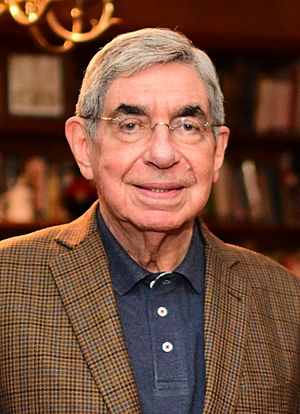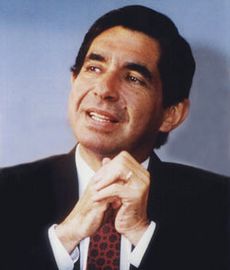Óscar Arias facts for kids
Quick facts for kids
Óscar Arias
|
|
|---|---|

Óscar Arias in April 2018
|
|
| 40th & 45th President of Costa Rica | |
| In office 8 May 2006 – 8 May 2010 |
|
| Vice President |
|
| Preceded by | Abel Pacheco |
| Succeeded by | Laura Chinchilla |
| In office 8 May 1986 – 8 May 1990 |
|
| Vice President |
|
| Preceded by | Luis Alberto Monge |
| Succeeded by | Rafael Ángel Calderón |
| Deputy of the Legislative Assembly of Costa Rica | |
| In office 1 May 1978 – 2 May 1981 |
|
| Preceded by | Jorge Luis Arce |
| Succeeded by | Gerardo Vega |
| Constituency | Heredia (2nd Office) |
| Minister of National Planning | |
| In office May 1974 – July 1977 |
|
| President | Daniel Oduber |
| Preceded by | Himself |
| Succeeded by | Fernando Zumbado |
| Director of the Office of National Planning | |
| In office 1971–1974 |
|
| President | José Figueres |
| Preceded by | Marco López |
| Succeeded by | Himself |
| Personal details | |
| Born |
Óscar Arias Sánchez
13 September 1940 Heredia, Costa Rica |
| Political party | National Liberation Party |
| Alma mater | Boston University University of Costa Rica London School of Economics University of Essex |
| Signature | |
Óscar Arias Sánchez (born 13 September 1940 in Heredia, Costa Rica) is a Costa Rican lawyer, economist, and political scientist. He served as President for two terms: from 1986 to 1990 and again from 2006 to 2010.
In 1987, he won the Nobel Peace Prize. This award was for his plan to help end the civil wars happening in Central America. His plan was supported by Costa Rica, Guatemala, El Salvador, Honduras, and Nicaragua.
The plan aimed to make sure countries had free elections, protected human rights, and stopped outside countries from interfering. It was a guide for peace and democracy in Central America during a difficult time. Thanks to Arias, many conflicts in the region ended over the next ten years.
Óscar Arias has received many other awards. These include the Albert Schweitzer Humanitarian Award. He also has 93 honorary doctorates from universities around the world.
Contents
Notable University Awards
| University | Country |
| University of Costa Rica | Costa Rica |
| Harvard University | United States of America |
| Princeton University | United States of America |
| Dartmouth College | United States of America |
| Oberlin College | United States of America |
| Ithaca College | United States of America |
| Washington University in St. Louis | United States of America |
| University of Oviedo | Spain |
| Alfonso X el Sabio University | Spain |
| National Technical University (UTN) | Costa Rica |
| Cecilio Acosta Catholic University | Venezuela |
| University of Salamanca | Spain |
| Bahçeşehir University | Turkey |
| Yonsei University | South Korea |
| Kyung Hee University | South Korea |
International Awards
| Award | Country / Institution |
| Martin Luther King Jr. Peace Award | United States of America |
| Liberty Medal | Philadelphia, United States of America |
| Jackson H. Ralston Award | United States of America |
| Prince of Asturias Award (Cooperation) | Spain |
| Albert Schweitzer Humanitarian Award | United States / International |
| Americas Award | International |
Arias was a trustee for Economists for Peace and Security. In 2003, he joined the board for the Trust Fund for Victims of the International Criminal Court.
He studied Law and Economics at the University of Costa Rica. He also studied Political Science at the University of Essex in the United Kingdom. He has two children, Silvya Eugenia and Óscar Felipe, from his first marriage to Margarita Penón Góngora. Later, he married Suzanne Fischel Kopper.
Early Life and Education
Óscar Arias Sánchez was born in San José on September 13, 1940. He grew up in Heredia, in a family that grew coffee. His parents were Juan Rafael Arias Trejos and Lylliam Sánchez Cortés. His grandfather, Juan Rafael Arias Bonilla, was also a politician. He served in Congress and held government jobs.
Arias went to Saint Francis School in San José. He first wanted to study medicine but chose Law and Economics at the University of Costa Rica. His college paper, “Pressure Groups in Costa Rica,” won an award in 1971.
He later earned a Ph.D. in Political Science from the University of Essex. His paper was about leadership in Costa Rica. While studying, he joined the National Liberation Party.
In 1971, President José Figueres Ferrer made him Director of the National Planning Office. This job involved managing the national budget. He stayed in this role under President Daniel Oduber (1974–1978). Then, he ran for Congress and was elected in 1978.
Presidential Terms
First Term: 1986–1990
In 1986, Arias became President as the candidate for the National Liberation Party. When he took office, Costa Rica faced high inflation and relied on foreign loans. Also, nearby Central American countries were in civil wars, which threatened Costa Rica's peace.
To fix these problems, his government worked to make the economy stronger and bring peace to Central America. Here are some of his achievements:
- He helped stabilize the economy by making trade more open.
- He worked with the IMF and World Bank to improve the economy.
- Inflation, which was over 22%, dropped to 9%.
- Costa Rica started exporting new products like pineapples, flowers, and textiles.
- He promoted eco-tourism, which helped the economy grow.
These efforts helped Costa Rica's economy grow steadily in the 1990s.
Arias also improved government offices and invested a lot in public education. He believed education was key for development. His government gave out free textbooks and opened school libraries. By the end of his term, 95% of children were in primary school and 60% in secondary school.
Internationally, Arias's government disagreed with the U.S. and the Soviet Union. These superpowers were interfering in Central American conflicts. Arias's biggest success was his Peace Plan, which helped end military conflicts in the region. The plan included:
- Agreements for ceasefires (stopping fighting).
- Steps towards democracy.
- Free and fair elections.
- Protection of human rights.
- Stopping foreign support for armed groups.
This plan won Arias the Nobel Peace Prize in 1987. He was the first person from Costa Rica and Central America to receive this honor. He used the award to promote nuclear disarmament and encourage spending on education, social welfare, and protecting the environment instead of military.
Second Term: 2006–2010
A law from 1969 stopped former presidents from running again. But in 2003, this rule was changed. This allowed Arias to run for president a second time.
When Arias returned to power, Costa Rica's infrastructure was old. People also wanted more economic growth and were divided. Here are some highlights from his second term:
- CAFTA-DR Approval: In 2007, voters approved the Free Trade Agreement with the United States. This was a big step for the economy. It helped Costa Rica access major global markets and brought reforms in telecommunications and insurance.
- Infrastructure Improvements: New projects included building Route 27, which connects San José to Caldera. The Juan Santamaría and Daniel Oduber international airports were also expanded. Roads and ports were modernized.
- Poverty Reduction: A program called Avancemos was started to help reduce high school dropout rates. Other social programs were also expanded.
Arias's diplomacy brought Costa Rica global recognition. In 2007, he became a UN Messenger of Peace. He often spoke at global events like the World Economic Forum.
Costa Rica also gained praise for being a leader in sustainability. It expanded protected areas and achieved 95% renewable energy. The country also worked towards carbon neutrality.
In June 2007, Costa Rica ended its ties with Taiwan and started diplomatic relations with China. This was an important foreign policy decision.
2009 Honduras Crisis
After a political crisis in Honduras, Arias was asked by the Organization of American States to help find a solution. He offered a plan to bring peace, and his involvement helped calm the situation.
5th Summit of the Americas
On April 18, 2009, Arias gave an important speech at the Summit of the Americas in Trinidad and Tobago. He talked about the economic and social challenges in Latin America. He urged leaders to focus more on education, environmental protection, and healthcare, instead of spending too much on weapons.
Arias Foundation for Peace
Arias used the money from his 1987 Nobel Peace Prize to create the Arias Foundation for Peace and Human Progress. This foundation has three main programs:
- The Center for Human Progress helps promote equality for women in Central America.
- The Center for Organized Participation encourages charitable work in Latin America.
- The Center for Peace and Reconciliation works to reduce military spending and resolve conflicts in developing countries.
Arms Trade Treaty
On May 29, 1997, Arias and other Nobel laureates presented an International Code of Conduct on Arms Transfers. This code aimed to set ethical rules for the global arms trade. The goal was to reduce its impact on human rights and conflicts. The Arias Foundation led this effort with other groups like Amnesty International.
In 2005, the Central American Integration System (SICA) used this idea to create its own code for arms transfers in Central America.
In 2006, Arias officially presented the Arms Trade Treaty (ATT) idea to the UN General Assembly. Costa Rica, Argentina, Australia, and other countries supported it. The UN General Assembly adopted a resolution to start working on the treaty. After years of diplomatic efforts, the Arms Trade Treaty was adopted on April 2, 2013. It officially became law on December 24, 2014, after enough countries approved it. Today, 116 countries are part of this important agreement. It is a big step in controlling conventional weapons and shows Costa Rica's commitment to peace.
Images for kids
-
Arias with Barack Obama on 17 April 2009
See also
 In Spanish: Óscar Arias Sánchez para niños
In Spanish: Óscar Arias Sánchez para niños




